MGT5STR: Analyzing Competitive Environment & Strategy at Wesfarmers
VerifiedAdded on 2023/06/13
|25
|8041
|241
Report
AI Summary
This report provides an in-depth analysis of Wesfarmers Limited, focusing on its competitive environment and corporate-level strategy. It identifies Wesfarmers' diversified business operations, highlighting Coles as the primary revenue center, and examines the sources of its sustainable competitive advantage using the VRIN model. The report includes a PESTEL analysis of the Australian market, considering political, economic, socio-cultural, technological, environmental, and legal factors, followed by a SWOT analysis to assess Wesfarmers' strengths, weaknesses, opportunities, and threats. Strategic recommendations regarding mergers, acquisitions, or downsizing are offered based on the analysis, providing insights into Wesfarmers' strategic direction and potential future actions. The report utilizes scholarly journals and secondary sources to support its findings.
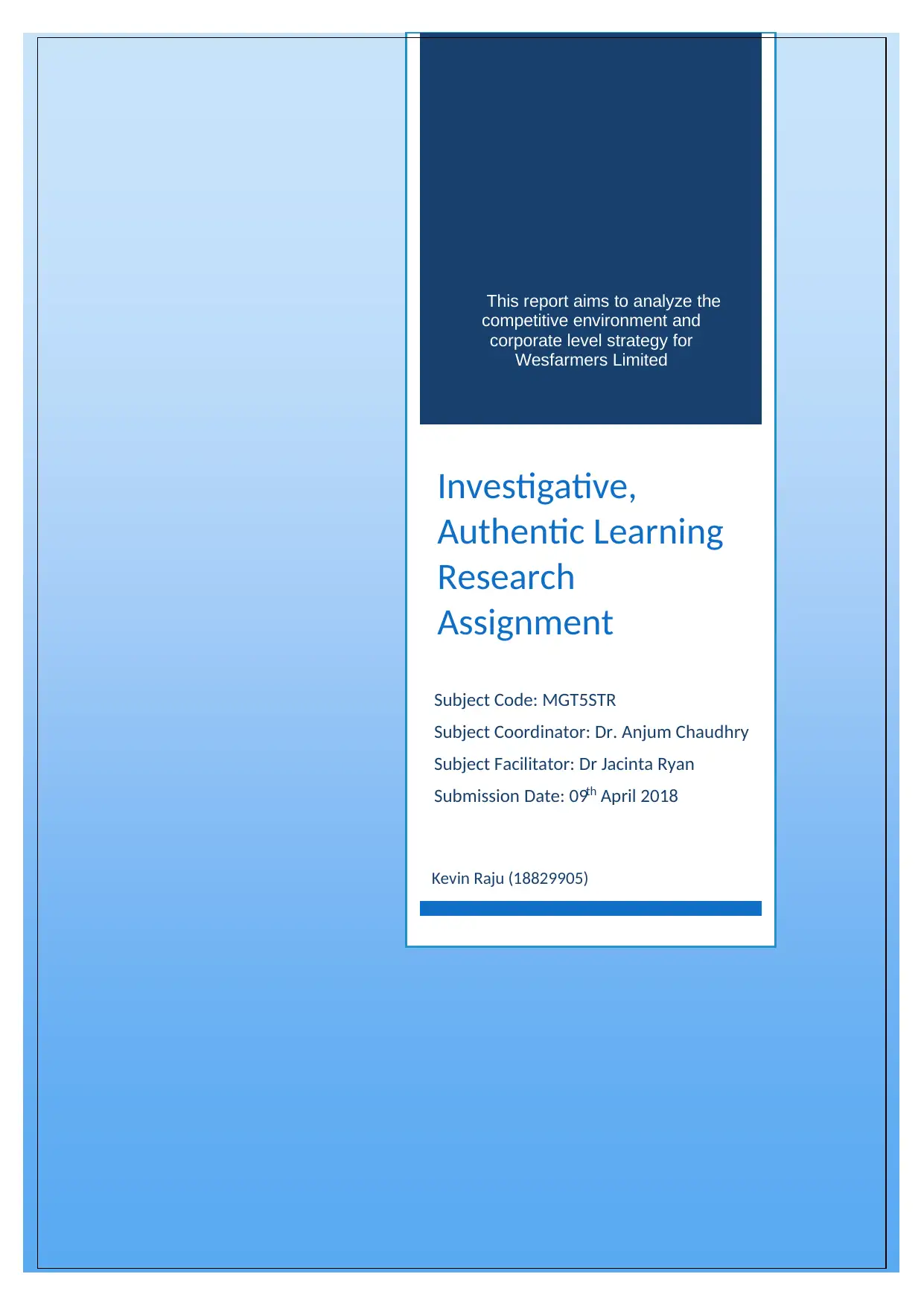
This report aims to analyze the
competitive environment and
corporate level strategy for
Wesfarmers Limited
Investigative,
Authentic Learning
Research
Assignment
Kevin Raju (18829905)
Subject Code: MGT5STR
Subject Coordinator: Dr. Anjum Chaudhry
Subject Facilitator: Dr Jacinta Ryan
Submission Date: 09th April 2018
competitive environment and
corporate level strategy for
Wesfarmers Limited
Investigative,
Authentic Learning
Research
Assignment
Kevin Raju (18829905)
Subject Code: MGT5STR
Subject Coordinator: Dr. Anjum Chaudhry
Subject Facilitator: Dr Jacinta Ryan
Submission Date: 09th April 2018
Paraphrase This Document
Need a fresh take? Get an instant paraphrase of this document with our AI Paraphraser
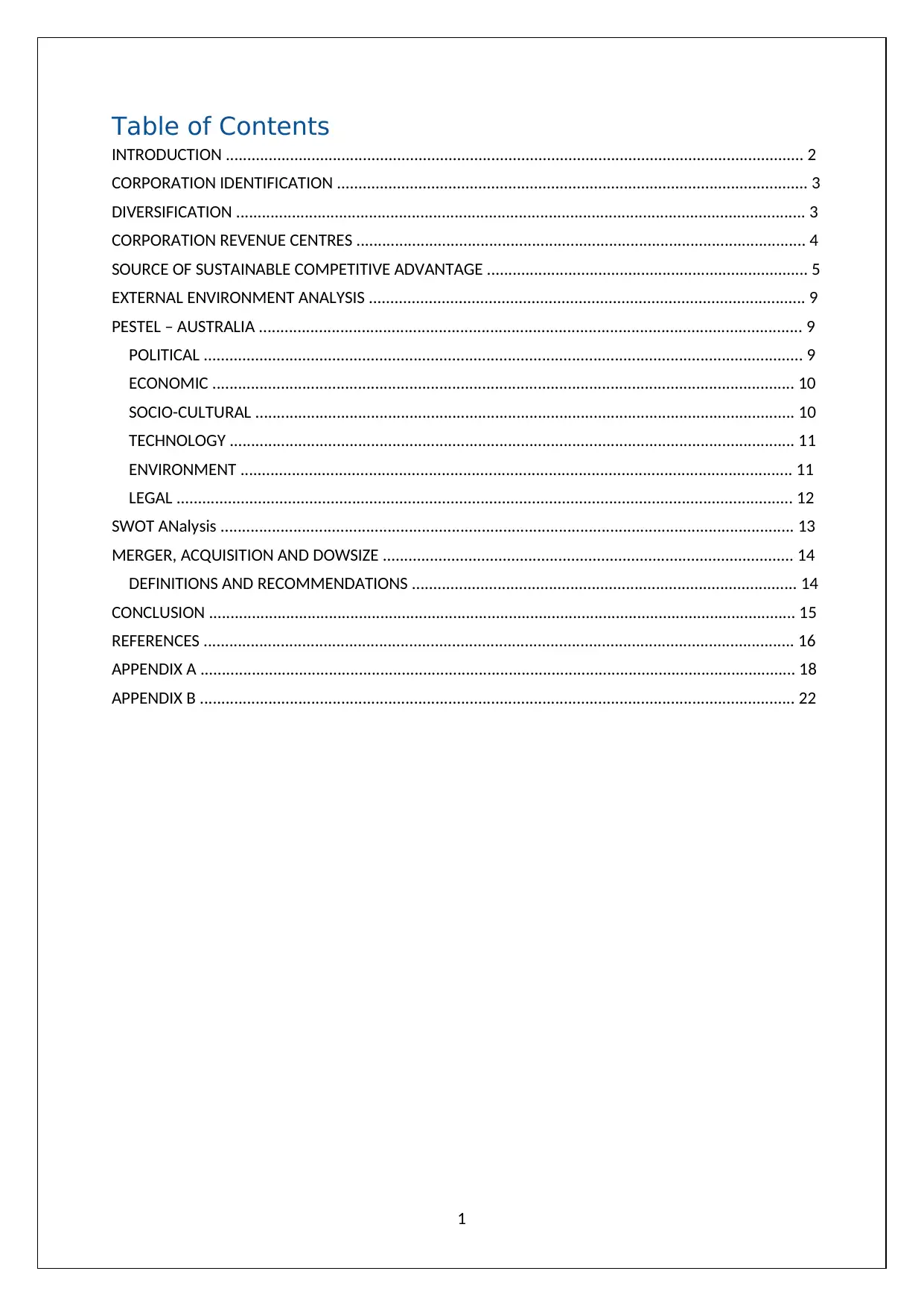
1
Table of Contents
INTRODUCTION ....................................................................................................................................... 2
CORPORATION IDENTIFICATION .............................................................................................................. 3
DIVERSIFICATION ..................................................................................................................................... 3
CORPORATION REVENUE CENTRES ......................................................................................................... 4
SOURCE OF SUSTAINABLE COMPETITIVE ADVANTAGE ........................................................................... 5
EXTERNAL ENVIRONMENT ANALYSIS ...................................................................................................... 9
PESTEL – AUSTRALIA ............................................................................................................................... 9
POLITICAL ............................................................................................................................................ 9
ECONOMIC ........................................................................................................................................ 10
SOCIO-CULTURAL .............................................................................................................................. 10
TECHNOLOGY .................................................................................................................................... 11
ENVIRONMENT ................................................................................................................................. 11
LEGAL ................................................................................................................................................ 12
SWOT ANalysis ...................................................................................................................................... 13
MERGER, ACQUISITION AND DOWSIZE ................................................................................................ 14
DEFINITIONS AND RECOMMENDATIONS .......................................................................................... 14
CONCLUSION ......................................................................................................................................... 15
REFERENCES .......................................................................................................................................... 16
APPENDIX A ........................................................................................................................................... 18
APPENDIX B ........................................................................................................................................... 22
Table of Contents
INTRODUCTION ....................................................................................................................................... 2
CORPORATION IDENTIFICATION .............................................................................................................. 3
DIVERSIFICATION ..................................................................................................................................... 3
CORPORATION REVENUE CENTRES ......................................................................................................... 4
SOURCE OF SUSTAINABLE COMPETITIVE ADVANTAGE ........................................................................... 5
EXTERNAL ENVIRONMENT ANALYSIS ...................................................................................................... 9
PESTEL – AUSTRALIA ............................................................................................................................... 9
POLITICAL ............................................................................................................................................ 9
ECONOMIC ........................................................................................................................................ 10
SOCIO-CULTURAL .............................................................................................................................. 10
TECHNOLOGY .................................................................................................................................... 11
ENVIRONMENT ................................................................................................................................. 11
LEGAL ................................................................................................................................................ 12
SWOT ANalysis ...................................................................................................................................... 13
MERGER, ACQUISITION AND DOWSIZE ................................................................................................ 14
DEFINITIONS AND RECOMMENDATIONS .......................................................................................... 14
CONCLUSION ......................................................................................................................................... 15
REFERENCES .......................................................................................................................................... 16
APPENDIX A ........................................................................................................................................... 18
APPENDIX B ........................................................................................................................................... 22
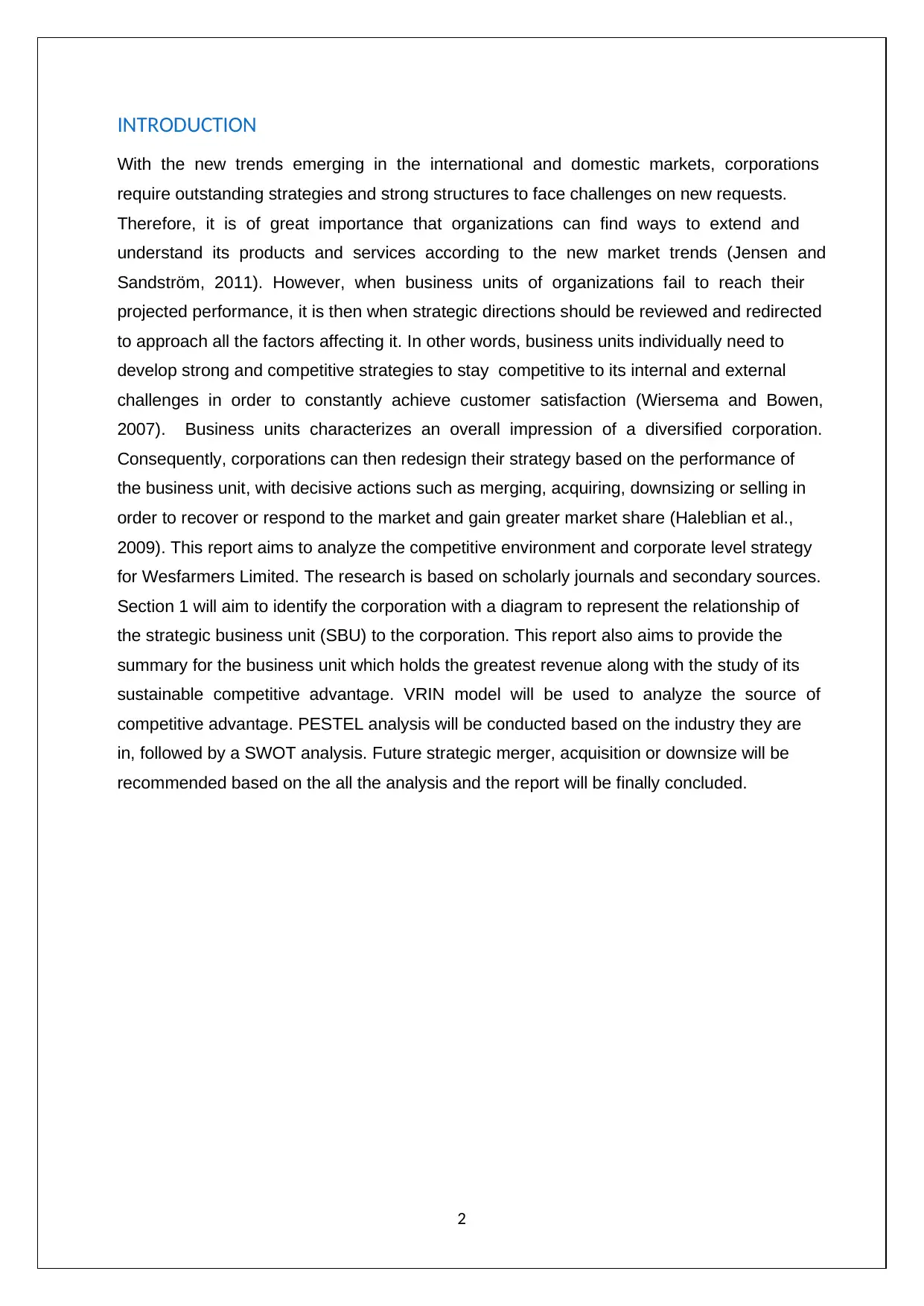
2
INTRODUCTION
With the new trends emerging in the international and domestic markets, corporations
require outstanding strategies and strong structures to face challenges on new requests.
Therefore, it is of great importance that organizations can find ways to extend and
understand its products and services according to the new market trends (Jensen and
Sandström, 2011). However, when business units of organizations fail to reach their
projected performance, it is then when strategic directions should be reviewed and redirected
to approach all the factors affecting it. In other words, business units individually need to
develop strong and competitive strategies to stay competitive to its internal and external
challenges in order to constantly achieve customer satisfaction (Wiersema and Bowen,
2007). Business units characterizes an overall impression of a diversified corporation.
Consequently, corporations can then redesign their strategy based on the performance of
the business unit, with decisive actions such as merging, acquiring, downsizing or selling in
order to recover or respond to the market and gain greater market share (Haleblian et al.,
2009). This report aims to analyze the competitive environment and corporate level strategy
for Wesfarmers Limited. The research is based on scholarly journals and secondary sources.
Section 1 will aim to identify the corporation with a diagram to represent the relationship of
the strategic business unit (SBU) to the corporation. This report also aims to provide the
summary for the business unit which holds the greatest revenue along with the study of its
sustainable competitive advantage. VRIN model will be used to analyze the source of
competitive advantage. PESTEL analysis will be conducted based on the industry they are
in, followed by a SWOT analysis. Future strategic merger, acquisition or downsize will be
recommended based on the all the analysis and the report will be finally concluded.
INTRODUCTION
With the new trends emerging in the international and domestic markets, corporations
require outstanding strategies and strong structures to face challenges on new requests.
Therefore, it is of great importance that organizations can find ways to extend and
understand its products and services according to the new market trends (Jensen and
Sandström, 2011). However, when business units of organizations fail to reach their
projected performance, it is then when strategic directions should be reviewed and redirected
to approach all the factors affecting it. In other words, business units individually need to
develop strong and competitive strategies to stay competitive to its internal and external
challenges in order to constantly achieve customer satisfaction (Wiersema and Bowen,
2007). Business units characterizes an overall impression of a diversified corporation.
Consequently, corporations can then redesign their strategy based on the performance of
the business unit, with decisive actions such as merging, acquiring, downsizing or selling in
order to recover or respond to the market and gain greater market share (Haleblian et al.,
2009). This report aims to analyze the competitive environment and corporate level strategy
for Wesfarmers Limited. The research is based on scholarly journals and secondary sources.
Section 1 will aim to identify the corporation with a diagram to represent the relationship of
the strategic business unit (SBU) to the corporation. This report also aims to provide the
summary for the business unit which holds the greatest revenue along with the study of its
sustainable competitive advantage. VRIN model will be used to analyze the source of
competitive advantage. PESTEL analysis will be conducted based on the industry they are
in, followed by a SWOT analysis. Future strategic merger, acquisition or downsize will be
recommended based on the all the analysis and the report will be finally concluded.
⊘ This is a preview!⊘
Do you want full access?
Subscribe today to unlock all pages.

Trusted by 1+ million students worldwide
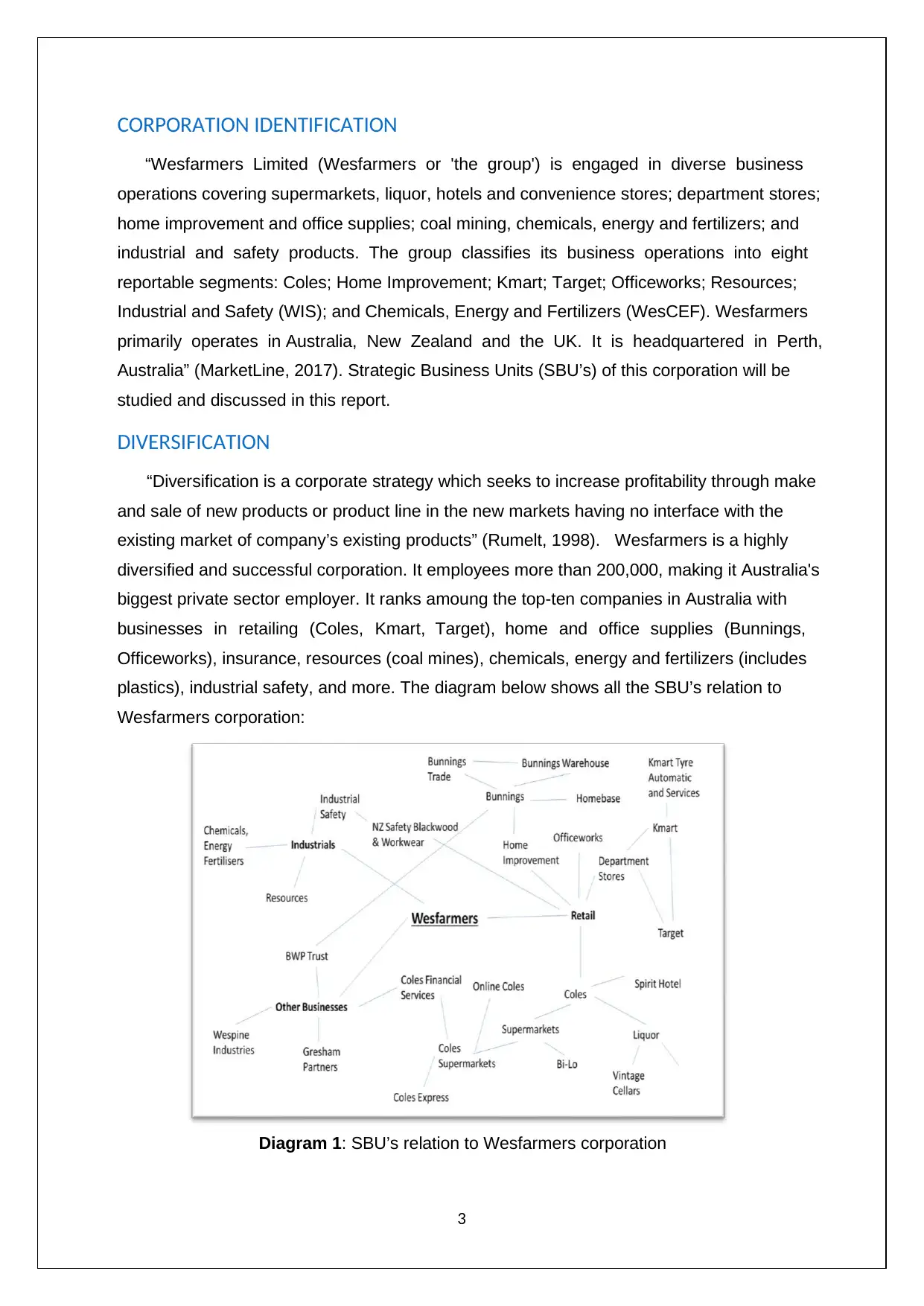
3
CORPORATION IDENTIFICATION
“Wesfarmers Limited (Wesfarmers or 'the group') is engaged in diverse business
operations covering supermarkets, liquor, hotels and convenience stores; department stores;
home improvement and office supplies; coal mining, chemicals, energy and fertilizers; and
industrial and safety products. The group classifies its business operations into eight
reportable segments: Coles; Home Improvement; Kmart; Target; Officeworks; Resources;
Industrial and Safety (WIS); and Chemicals, Energy and Fertilizers (WesCEF). Wesfarmers
primarily operates in Australia, New Zealand and the UK. It is headquartered in Perth,
Australia” (MarketLine, 2017). Strategic Business Units (SBU’s) of this corporation will be
studied and discussed in this report.
DIVERSIFICATION
“Diversification is a corporate strategy which seeks to increase profitability through make
and sale of new products or product line in the new markets having no interface with the
existing market of company’s existing products” (Rumelt, 1998). Wesfarmers is a highly
diversified and successful corporation. It employees more than 200,000, making it Australia's
biggest private sector employer. It ranks amoung the top-ten companies in Australia with
businesses in retailing (Coles, Kmart, Target), home and office supplies (Bunnings,
Officeworks), insurance, resources (coal mines), chemicals, energy and fertilizers (includes
plastics), industrial safety, and more. The diagram below shows all the SBU’s relation to
Wesfarmers corporation:
Diagram 1: SBU’s relation to Wesfarmers corporation
CORPORATION IDENTIFICATION
“Wesfarmers Limited (Wesfarmers or 'the group') is engaged in diverse business
operations covering supermarkets, liquor, hotels and convenience stores; department stores;
home improvement and office supplies; coal mining, chemicals, energy and fertilizers; and
industrial and safety products. The group classifies its business operations into eight
reportable segments: Coles; Home Improvement; Kmart; Target; Officeworks; Resources;
Industrial and Safety (WIS); and Chemicals, Energy and Fertilizers (WesCEF). Wesfarmers
primarily operates in Australia, New Zealand and the UK. It is headquartered in Perth,
Australia” (MarketLine, 2017). Strategic Business Units (SBU’s) of this corporation will be
studied and discussed in this report.
DIVERSIFICATION
“Diversification is a corporate strategy which seeks to increase profitability through make
and sale of new products or product line in the new markets having no interface with the
existing market of company’s existing products” (Rumelt, 1998). Wesfarmers is a highly
diversified and successful corporation. It employees more than 200,000, making it Australia's
biggest private sector employer. It ranks amoung the top-ten companies in Australia with
businesses in retailing (Coles, Kmart, Target), home and office supplies (Bunnings,
Officeworks), insurance, resources (coal mines), chemicals, energy and fertilizers (includes
plastics), industrial safety, and more. The diagram below shows all the SBU’s relation to
Wesfarmers corporation:
Diagram 1: SBU’s relation to Wesfarmers corporation
Paraphrase This Document
Need a fresh take? Get an instant paraphrase of this document with our AI Paraphraser
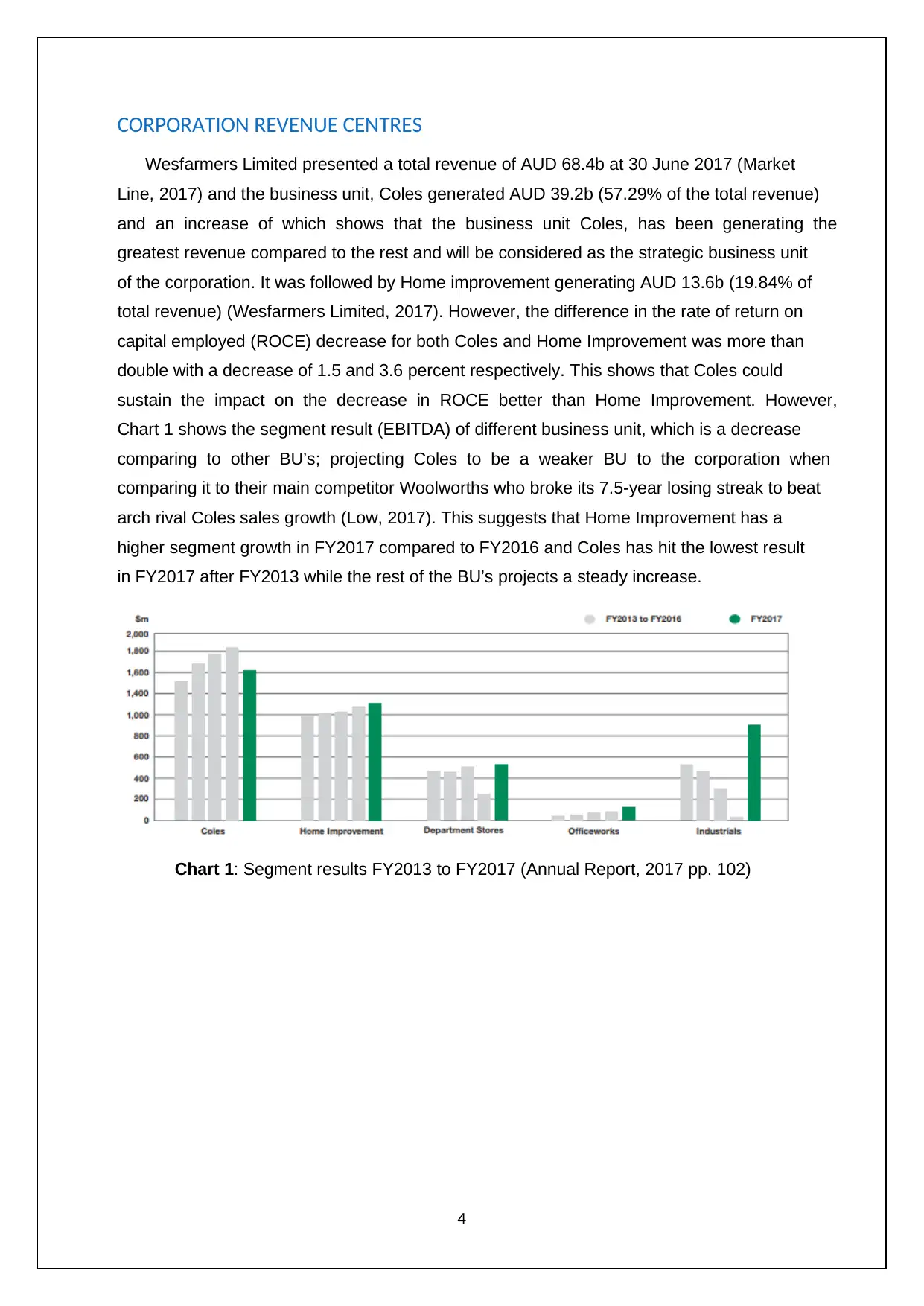
4
CORPORATION REVENUE CENTRES
Wesfarmers Limited presented a total revenue of AUD 68.4b at 30 June 2017 (Market
Line, 2017) and the business unit, Coles generated AUD 39.2b (57.29% of the total revenue)
and an increase of which shows that the business unit Coles, has been generating the
greatest revenue compared to the rest and will be considered as the strategic business unit
of the corporation. It was followed by Home improvement generating AUD 13.6b (19.84% of
total revenue) (Wesfarmers Limited, 2017). However, the difference in the rate of return on
capital employed (ROCE) decrease for both Coles and Home Improvement was more than
double with a decrease of 1.5 and 3.6 percent respectively. This shows that Coles could
sustain the impact on the decrease in ROCE better than Home Improvement. However,
Chart 1 shows the segment result (EBITDA) of different business unit, which is a decrease
comparing to other BU’s; projecting Coles to be a weaker BU to the corporation when
comparing it to their main competitor Woolworths who broke its 7.5-year losing streak to beat
arch rival Coles sales growth (Low, 2017). This suggests that Home Improvement has a
higher segment growth in FY2017 compared to FY2016 and Coles has hit the lowest result
in FY2017 after FY2013 while the rest of the BU’s projects a steady increase.
Chart 1: Segment results FY2013 to FY2017 (Annual Report, 2017 pp. 102)
CORPORATION REVENUE CENTRES
Wesfarmers Limited presented a total revenue of AUD 68.4b at 30 June 2017 (Market
Line, 2017) and the business unit, Coles generated AUD 39.2b (57.29% of the total revenue)
and an increase of which shows that the business unit Coles, has been generating the
greatest revenue compared to the rest and will be considered as the strategic business unit
of the corporation. It was followed by Home improvement generating AUD 13.6b (19.84% of
total revenue) (Wesfarmers Limited, 2017). However, the difference in the rate of return on
capital employed (ROCE) decrease for both Coles and Home Improvement was more than
double with a decrease of 1.5 and 3.6 percent respectively. This shows that Coles could
sustain the impact on the decrease in ROCE better than Home Improvement. However,
Chart 1 shows the segment result (EBITDA) of different business unit, which is a decrease
comparing to other BU’s; projecting Coles to be a weaker BU to the corporation when
comparing it to their main competitor Woolworths who broke its 7.5-year losing streak to beat
arch rival Coles sales growth (Low, 2017). This suggests that Home Improvement has a
higher segment growth in FY2017 compared to FY2016 and Coles has hit the lowest result
in FY2017 after FY2013 while the rest of the BU’s projects a steady increase.
Chart 1: Segment results FY2013 to FY2017 (Annual Report, 2017 pp. 102)
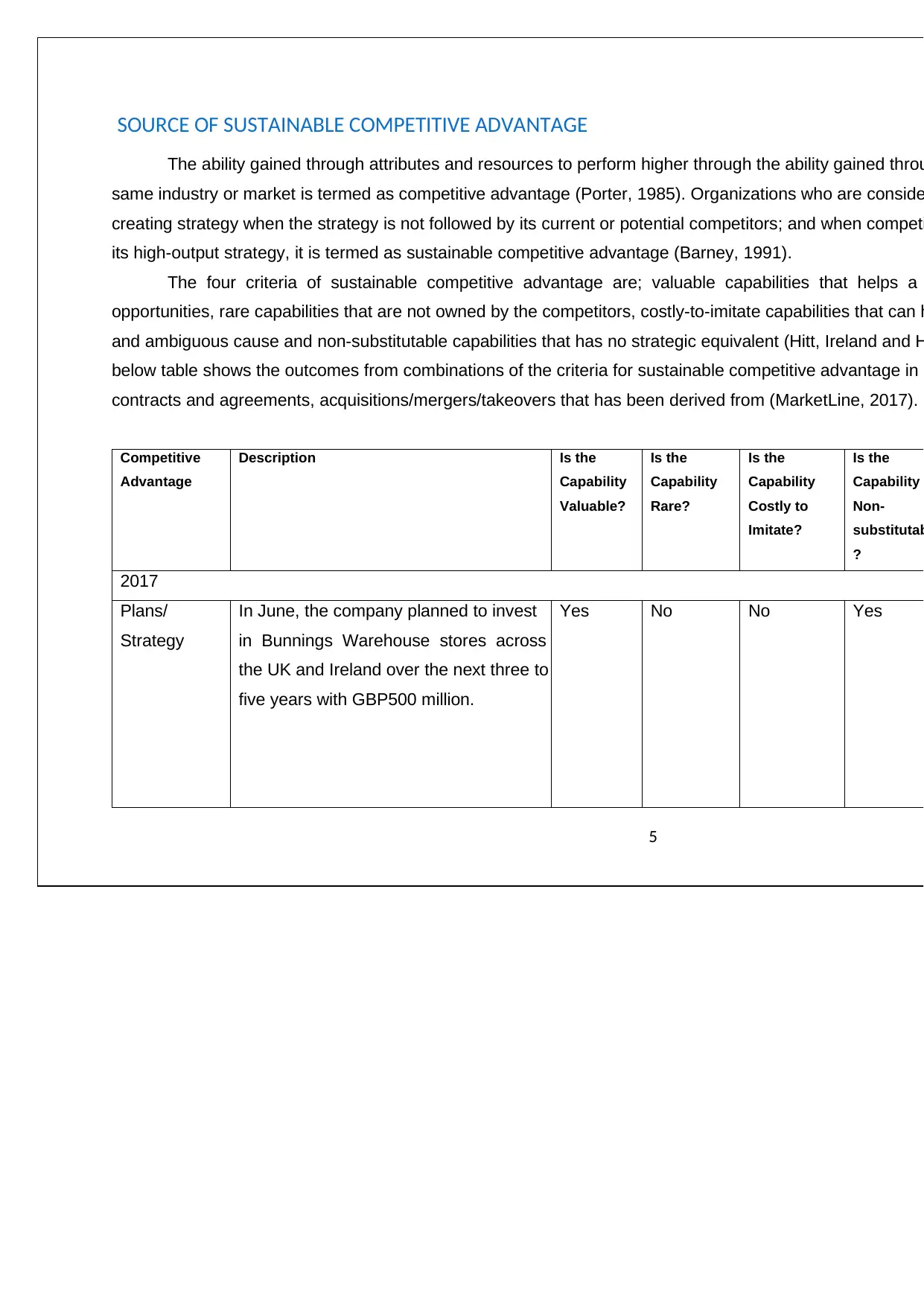
5
SOURCE OF SUSTAINABLE COMPETITIVE ADVANTAGE
The ability gained through attributes and resources to perform higher through the ability gained throu
same industry or market is termed as competitive advantage (Porter, 1985). Organizations who are conside
creating strategy when the strategy is not followed by its current or potential competitors; and when competi
its high-output strategy, it is termed as sustainable competitive advantage (Barney, 1991).
The four criteria of sustainable competitive advantage are; valuable capabilities that helps a
opportunities, rare capabilities that are not owned by the competitors, costly-to-imitate capabilities that can h
and ambiguous cause and non-substitutable capabilities that has no strategic equivalent (Hitt, Ireland and H
below table shows the outcomes from combinations of the criteria for sustainable competitive advantage in r
contracts and agreements, acquisitions/mergers/takeovers that has been derived from (MarketLine, 2017).
Competitive
Advantage
Description Is the
Capability
Valuable?
Is the
Capability
Rare?
Is the
Capability
Costly to
Imitate?
Is the
Capability
Non-
substitutab
?
2017
Plans/
Strategy
In June, the company planned to invest
in Bunnings Warehouse stores across
the UK and Ireland over the next three to
five years with GBP500 million.
Yes No No Yes
SOURCE OF SUSTAINABLE COMPETITIVE ADVANTAGE
The ability gained through attributes and resources to perform higher through the ability gained throu
same industry or market is termed as competitive advantage (Porter, 1985). Organizations who are conside
creating strategy when the strategy is not followed by its current or potential competitors; and when competi
its high-output strategy, it is termed as sustainable competitive advantage (Barney, 1991).
The four criteria of sustainable competitive advantage are; valuable capabilities that helps a
opportunities, rare capabilities that are not owned by the competitors, costly-to-imitate capabilities that can h
and ambiguous cause and non-substitutable capabilities that has no strategic equivalent (Hitt, Ireland and H
below table shows the outcomes from combinations of the criteria for sustainable competitive advantage in r
contracts and agreements, acquisitions/mergers/takeovers that has been derived from (MarketLine, 2017).
Competitive
Advantage
Description Is the
Capability
Valuable?
Is the
Capability
Rare?
Is the
Capability
Costly to
Imitate?
Is the
Capability
Non-
substitutab
?
2017
Plans/
Strategy
In June, the company planned to invest
in Bunnings Warehouse stores across
the UK and Ireland over the next three to
five years with GBP500 million.
Yes No No Yes
⊘ This is a preview!⊘
Do you want full access?
Subscribe today to unlock all pages.

Trusted by 1+ million students worldwide
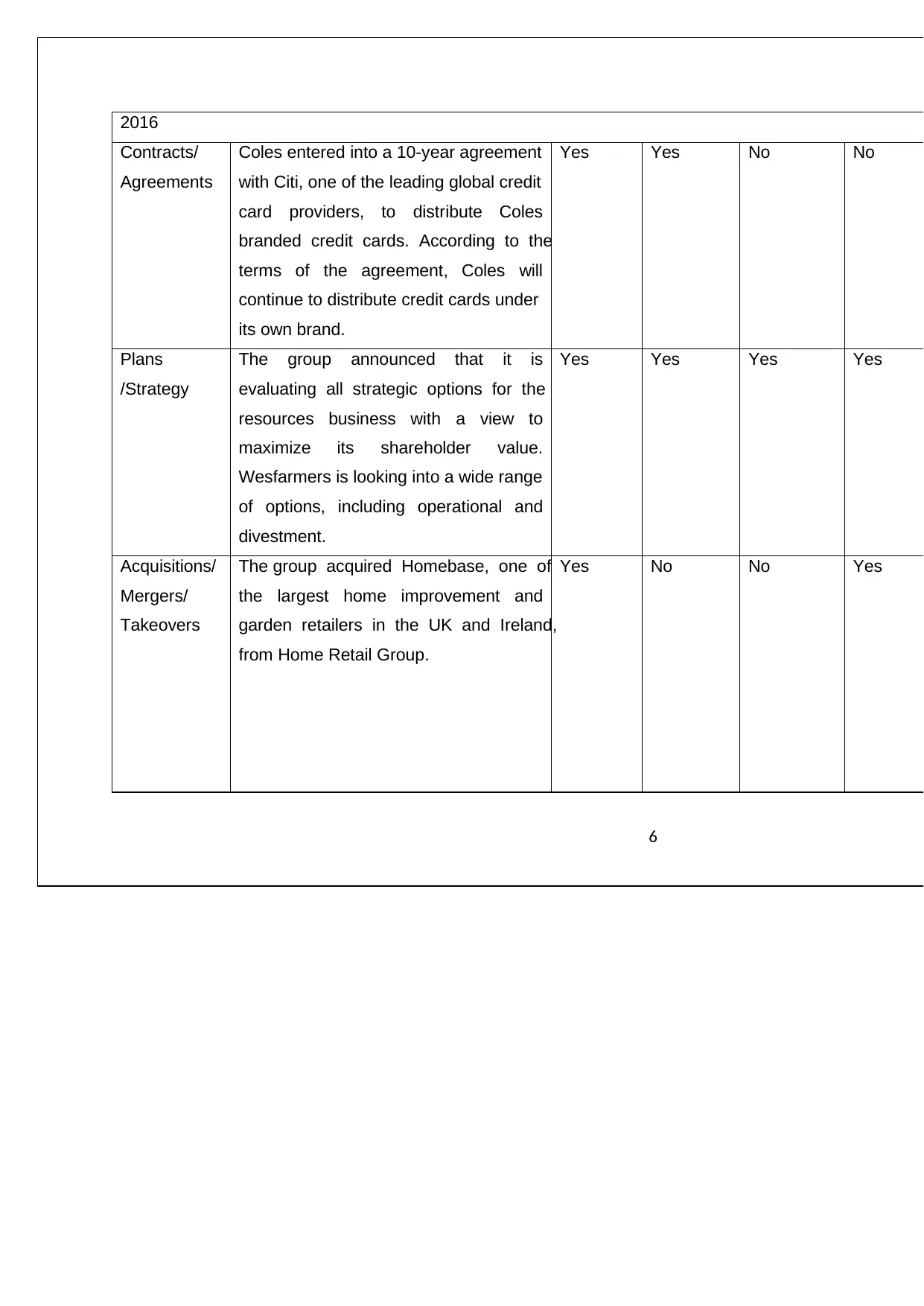
6
2016
Contracts/
Agreements
Coles entered into a 10-year agreement
with Citi, one of the leading global credit
card providers, to distribute Coles
branded credit cards. According to the
terms of the agreement, Coles will
continue to distribute credit cards under
its own brand.
Yes Yes No No
Plans
/Strategy
The group announced that it is
evaluating all strategic options for the
resources business with a view to
maximize its shareholder value.
Wesfarmers is looking into a wide range
of options, including operational and
divestment.
Yes Yes Yes Yes
Acquisitions/
Mergers/
Takeovers
The group acquired Homebase, one of
the largest home improvement and
garden retailers in the UK and Ireland,
from Home Retail Group.
Yes No No Yes
2016
Contracts/
Agreements
Coles entered into a 10-year agreement
with Citi, one of the leading global credit
card providers, to distribute Coles
branded credit cards. According to the
terms of the agreement, Coles will
continue to distribute credit cards under
its own brand.
Yes Yes No No
Plans
/Strategy
The group announced that it is
evaluating all strategic options for the
resources business with a view to
maximize its shareholder value.
Wesfarmers is looking into a wide range
of options, including operational and
divestment.
Yes Yes Yes Yes
Acquisitions/
Mergers/
Takeovers
The group acquired Homebase, one of
the largest home improvement and
garden retailers in the UK and Ireland,
from Home Retail Group.
Yes No No Yes
Paraphrase This Document
Need a fresh take? Get an instant paraphrase of this document with our AI Paraphraser
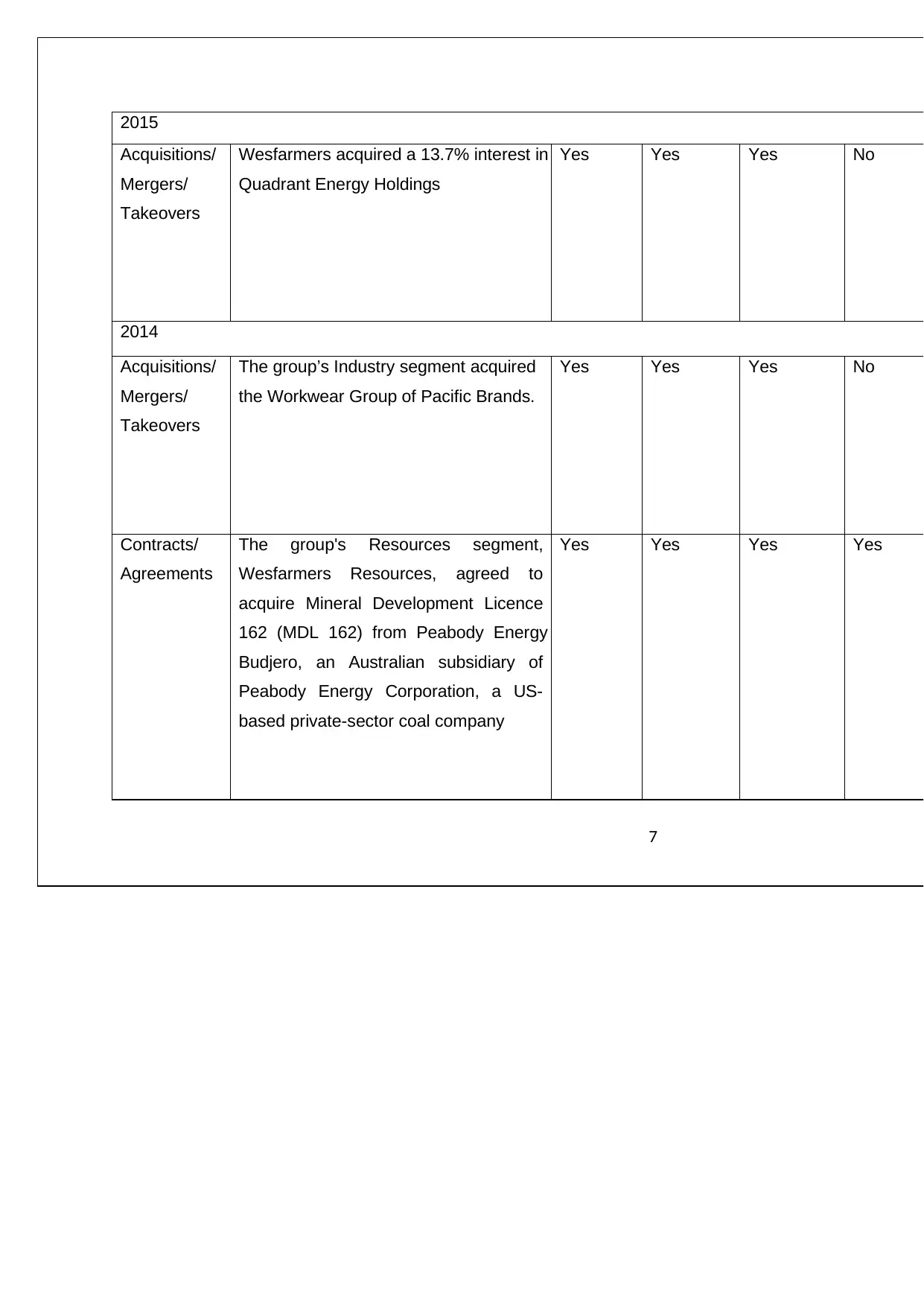
7
2015
Acquisitions/
Mergers/
Takeovers
Wesfarmers acquired a 13.7% interest in
Quadrant Energy Holdings
Yes Yes Yes No
2014
Acquisitions/
Mergers/
Takeovers
The group’s Industry segment acquired
the Workwear Group of Pacific Brands.
Yes Yes Yes No
Contracts/
Agreements
The group's Resources segment,
Wesfarmers Resources, agreed to
acquire Mineral Development Licence
162 (MDL 162) from Peabody Energy
Budjero, an Australian subsidiary of
Peabody Energy Corporation, a US-
based private-sector coal company
Yes Yes Yes Yes
2015
Acquisitions/
Mergers/
Takeovers
Wesfarmers acquired a 13.7% interest in
Quadrant Energy Holdings
Yes Yes Yes No
2014
Acquisitions/
Mergers/
Takeovers
The group’s Industry segment acquired
the Workwear Group of Pacific Brands.
Yes Yes Yes No
Contracts/
Agreements
The group's Resources segment,
Wesfarmers Resources, agreed to
acquire Mineral Development Licence
162 (MDL 162) from Peabody Energy
Budjero, an Australian subsidiary of
Peabody Energy Corporation, a US-
based private-sector coal company
Yes Yes Yes Yes
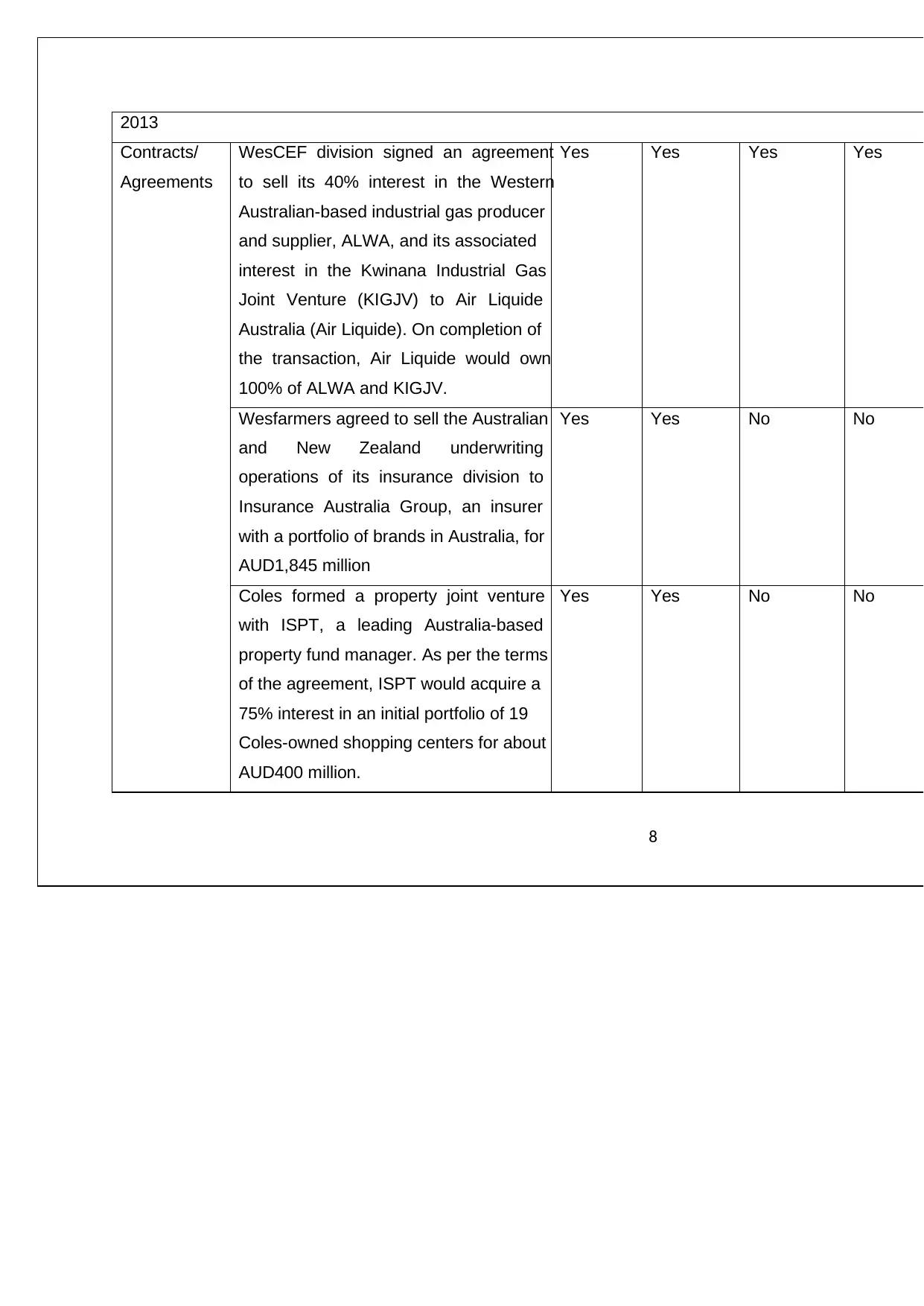
8
2013
Contracts/
Agreements
WesCEF division signed an agreement
to sell its 40% interest in the Western
Australian-based industrial gas producer
and supplier, ALWA, and its associated
interest in the Kwinana Industrial Gas
Joint Venture (KIGJV) to Air Liquide
Australia (Air Liquide). On completion of
the transaction, Air Liquide would own
100% of ALWA and KIGJV.
Yes Yes Yes Yes
Wesfarmers agreed to sell the Australian
and New Zealand underwriting
operations of its insurance division to
Insurance Australia Group, an insurer
with a portfolio of brands in Australia, for
AUD1,845 million
Yes Yes No No
Coles formed a property joint venture
with ISPT, a leading Australia-based
property fund manager. As per the terms
of the agreement, ISPT would acquire a
75% interest in an initial portfolio of 19
Coles-owned shopping centers for about
AUD400 million.
Yes Yes No No
2013
Contracts/
Agreements
WesCEF division signed an agreement
to sell its 40% interest in the Western
Australian-based industrial gas producer
and supplier, ALWA, and its associated
interest in the Kwinana Industrial Gas
Joint Venture (KIGJV) to Air Liquide
Australia (Air Liquide). On completion of
the transaction, Air Liquide would own
100% of ALWA and KIGJV.
Yes Yes Yes Yes
Wesfarmers agreed to sell the Australian
and New Zealand underwriting
operations of its insurance division to
Insurance Australia Group, an insurer
with a portfolio of brands in Australia, for
AUD1,845 million
Yes Yes No No
Coles formed a property joint venture
with ISPT, a leading Australia-based
property fund manager. As per the terms
of the agreement, ISPT would acquire a
75% interest in an initial portfolio of 19
Coles-owned shopping centers for about
AUD400 million.
Yes Yes No No
⊘ This is a preview!⊘
Do you want full access?
Subscribe today to unlock all pages.

Trusted by 1+ million students worldwide
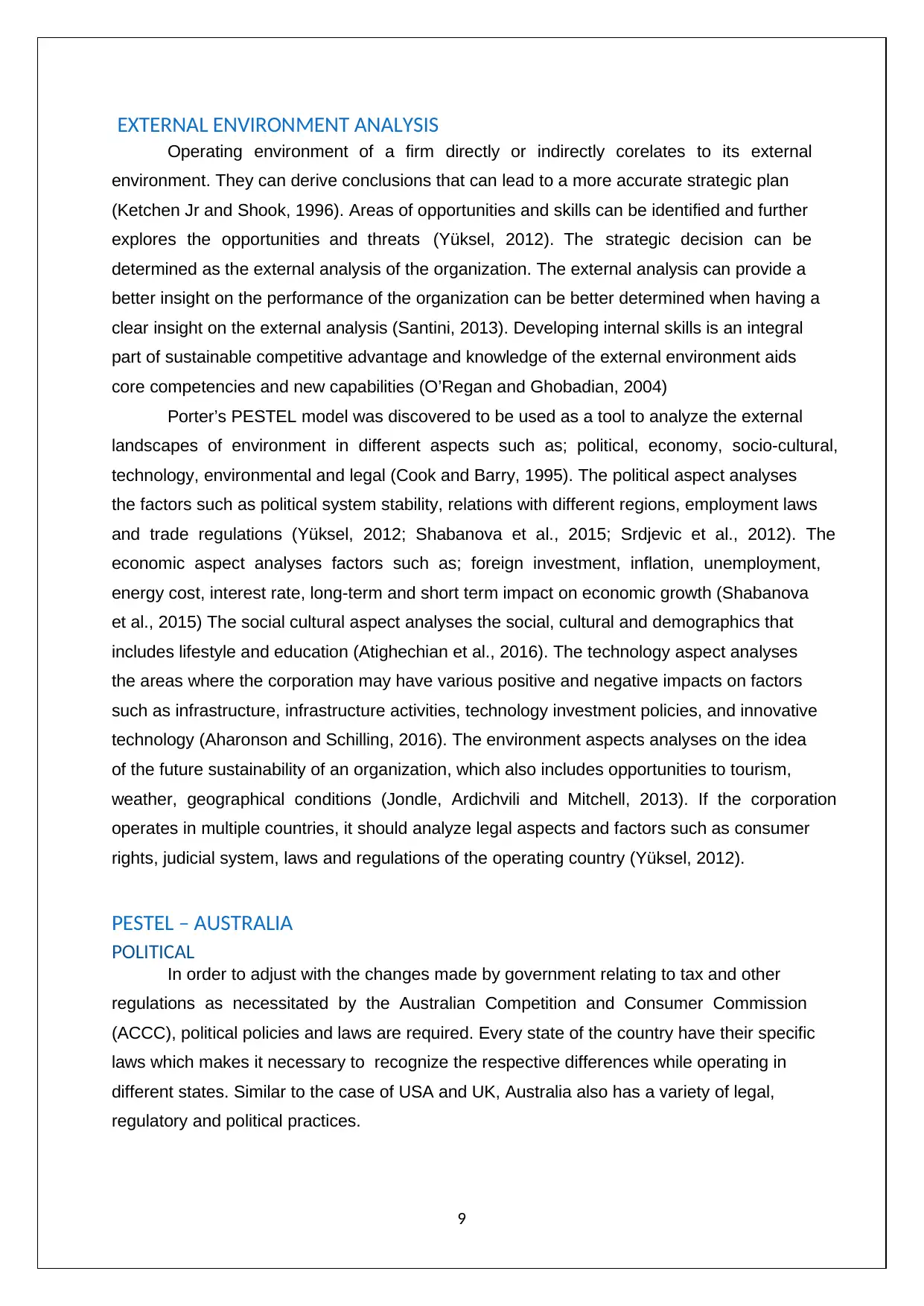
9
EXTERNAL ENVIRONMENT ANALYSIS
Operating environment of a firm directly or indirectly corelates to its external
environment. They can derive conclusions that can lead to a more accurate strategic plan
(Ketchen Jr and Shook, 1996). Areas of opportunities and skills can be identified and further
explores the opportunities and threats (Yüksel, 2012). The strategic decision can be
determined as the external analysis of the organization. The external analysis can provide a
better insight on the performance of the organization can be better determined when having a
clear insight on the external analysis (Santini, 2013). Developing internal skills is an integral
part of sustainable competitive advantage and knowledge of the external environment aids
core competencies and new capabilities (O’Regan and Ghobadian, 2004)
Porter’s PESTEL model was discovered to be used as a tool to analyze the external
landscapes of environment in different aspects such as; political, economy, socio-cultural,
technology, environmental and legal (Cook and Barry, 1995). The political aspect analyses
the factors such as political system stability, relations with different regions, employment laws
and trade regulations (Yüksel, 2012; Shabanova et al., 2015; Srdjevic et al., 2012). The
economic aspect analyses factors such as; foreign investment, inflation, unemployment,
energy cost, interest rate, long-term and short term impact on economic growth (Shabanova
et al., 2015) The social cultural aspect analyses the social, cultural and demographics that
includes lifestyle and education (Atighechian et al., 2016). The technology aspect analyses
the areas where the corporation may have various positive and negative impacts on factors
such as infrastructure, infrastructure activities, technology investment policies, and innovative
technology (Aharonson and Schilling, 2016). The environment aspects analyses on the idea
of the future sustainability of an organization, which also includes opportunities to tourism,
weather, geographical conditions (Jondle, Ardichvili and Mitchell, 2013). If the corporation
operates in multiple countries, it should analyze legal aspects and factors such as consumer
rights, judicial system, laws and regulations of the operating country (Yüksel, 2012).
PESTEL – AUSTRALIA
POLITICAL
In order to adjust with the changes made by government relating to tax and other
regulations as necessitated by the Australian Competition and Consumer Commission
(ACCC), political policies and laws are required. Every state of the country have their specific
laws which makes it necessary to recognize the respective differences while operating in
different states. Similar to the case of USA and UK, Australia also has a variety of legal,
regulatory and political practices.
EXTERNAL ENVIRONMENT ANALYSIS
Operating environment of a firm directly or indirectly corelates to its external
environment. They can derive conclusions that can lead to a more accurate strategic plan
(Ketchen Jr and Shook, 1996). Areas of opportunities and skills can be identified and further
explores the opportunities and threats (Yüksel, 2012). The strategic decision can be
determined as the external analysis of the organization. The external analysis can provide a
better insight on the performance of the organization can be better determined when having a
clear insight on the external analysis (Santini, 2013). Developing internal skills is an integral
part of sustainable competitive advantage and knowledge of the external environment aids
core competencies and new capabilities (O’Regan and Ghobadian, 2004)
Porter’s PESTEL model was discovered to be used as a tool to analyze the external
landscapes of environment in different aspects such as; political, economy, socio-cultural,
technology, environmental and legal (Cook and Barry, 1995). The political aspect analyses
the factors such as political system stability, relations with different regions, employment laws
and trade regulations (Yüksel, 2012; Shabanova et al., 2015; Srdjevic et al., 2012). The
economic aspect analyses factors such as; foreign investment, inflation, unemployment,
energy cost, interest rate, long-term and short term impact on economic growth (Shabanova
et al., 2015) The social cultural aspect analyses the social, cultural and demographics that
includes lifestyle and education (Atighechian et al., 2016). The technology aspect analyses
the areas where the corporation may have various positive and negative impacts on factors
such as infrastructure, infrastructure activities, technology investment policies, and innovative
technology (Aharonson and Schilling, 2016). The environment aspects analyses on the idea
of the future sustainability of an organization, which also includes opportunities to tourism,
weather, geographical conditions (Jondle, Ardichvili and Mitchell, 2013). If the corporation
operates in multiple countries, it should analyze legal aspects and factors such as consumer
rights, judicial system, laws and regulations of the operating country (Yüksel, 2012).
PESTEL – AUSTRALIA
POLITICAL
In order to adjust with the changes made by government relating to tax and other
regulations as necessitated by the Australian Competition and Consumer Commission
(ACCC), political policies and laws are required. Every state of the country have their specific
laws which makes it necessary to recognize the respective differences while operating in
different states. Similar to the case of USA and UK, Australia also has a variety of legal,
regulatory and political practices.
Paraphrase This Document
Need a fresh take? Get an instant paraphrase of this document with our AI Paraphraser
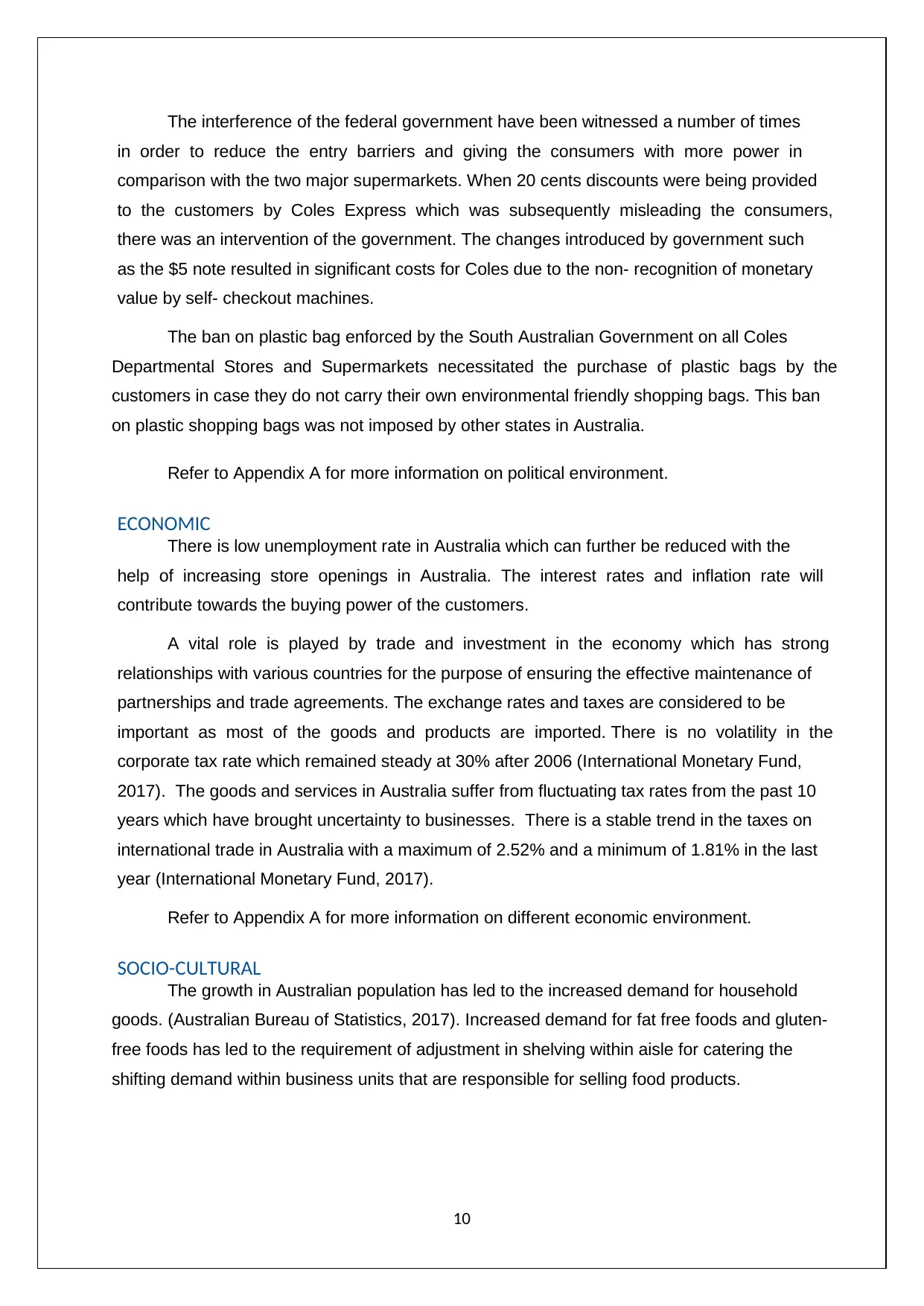
10
The interference of the federal government have been witnessed a number of times
in order to reduce the entry barriers and giving the consumers with more power in
comparison with the two major supermarkets. When 20 cents discounts were being provided
to the customers by Coles Express which was subsequently misleading the consumers,
there was an intervention of the government. The changes introduced by government such
as the $5 note resulted in significant costs for Coles due to the non- recognition of monetary
value by self- checkout machines.
The ban on plastic bag enforced by the South Australian Government on all Coles
Departmental Stores and Supermarkets necessitated the purchase of plastic bags by the
customers in case they do not carry their own environmental friendly shopping bags. This ban
on plastic shopping bags was not imposed by other states in Australia.
Refer to Appendix A for more information on political environment.
ECONOMIC
There is low unemployment rate in Australia which can further be reduced with the
help of increasing store openings in Australia. The interest rates and inflation rate will
contribute towards the buying power of the customers.
A vital role is played by trade and investment in the economy which has strong
relationships with various countries for the purpose of ensuring the effective maintenance of
partnerships and trade agreements. The exchange rates and taxes are considered to be
important as most of the goods and products are imported. There is no volatility in the
corporate tax rate which remained steady at 30% after 2006 (International Monetary Fund,
2017). The goods and services in Australia suffer from fluctuating tax rates from the past 10
years which have brought uncertainty to businesses. There is a stable trend in the taxes on
international trade in Australia with a maximum of 2.52% and a minimum of 1.81% in the last
year (International Monetary Fund, 2017).
Refer to Appendix A for more information on different economic environment.
SOCIO-CULTURAL
The growth in Australian population has led to the increased demand for household
goods. (Australian Bureau of Statistics, 2017). Increased demand for fat free foods and gluten-
free foods has led to the requirement of adjustment in shelving within aisle for catering the
shifting demand within business units that are responsible for selling food products.
The interference of the federal government have been witnessed a number of times
in order to reduce the entry barriers and giving the consumers with more power in
comparison with the two major supermarkets. When 20 cents discounts were being provided
to the customers by Coles Express which was subsequently misleading the consumers,
there was an intervention of the government. The changes introduced by government such
as the $5 note resulted in significant costs for Coles due to the non- recognition of monetary
value by self- checkout machines.
The ban on plastic bag enforced by the South Australian Government on all Coles
Departmental Stores and Supermarkets necessitated the purchase of plastic bags by the
customers in case they do not carry their own environmental friendly shopping bags. This ban
on plastic shopping bags was not imposed by other states in Australia.
Refer to Appendix A for more information on political environment.
ECONOMIC
There is low unemployment rate in Australia which can further be reduced with the
help of increasing store openings in Australia. The interest rates and inflation rate will
contribute towards the buying power of the customers.
A vital role is played by trade and investment in the economy which has strong
relationships with various countries for the purpose of ensuring the effective maintenance of
partnerships and trade agreements. The exchange rates and taxes are considered to be
important as most of the goods and products are imported. There is no volatility in the
corporate tax rate which remained steady at 30% after 2006 (International Monetary Fund,
2017). The goods and services in Australia suffer from fluctuating tax rates from the past 10
years which have brought uncertainty to businesses. There is a stable trend in the taxes on
international trade in Australia with a maximum of 2.52% and a minimum of 1.81% in the last
year (International Monetary Fund, 2017).
Refer to Appendix A for more information on different economic environment.
SOCIO-CULTURAL
The growth in Australian population has led to the increased demand for household
goods. (Australian Bureau of Statistics, 2017). Increased demand for fat free foods and gluten-
free foods has led to the requirement of adjustment in shelving within aisle for catering the
shifting demand within business units that are responsible for selling food products.
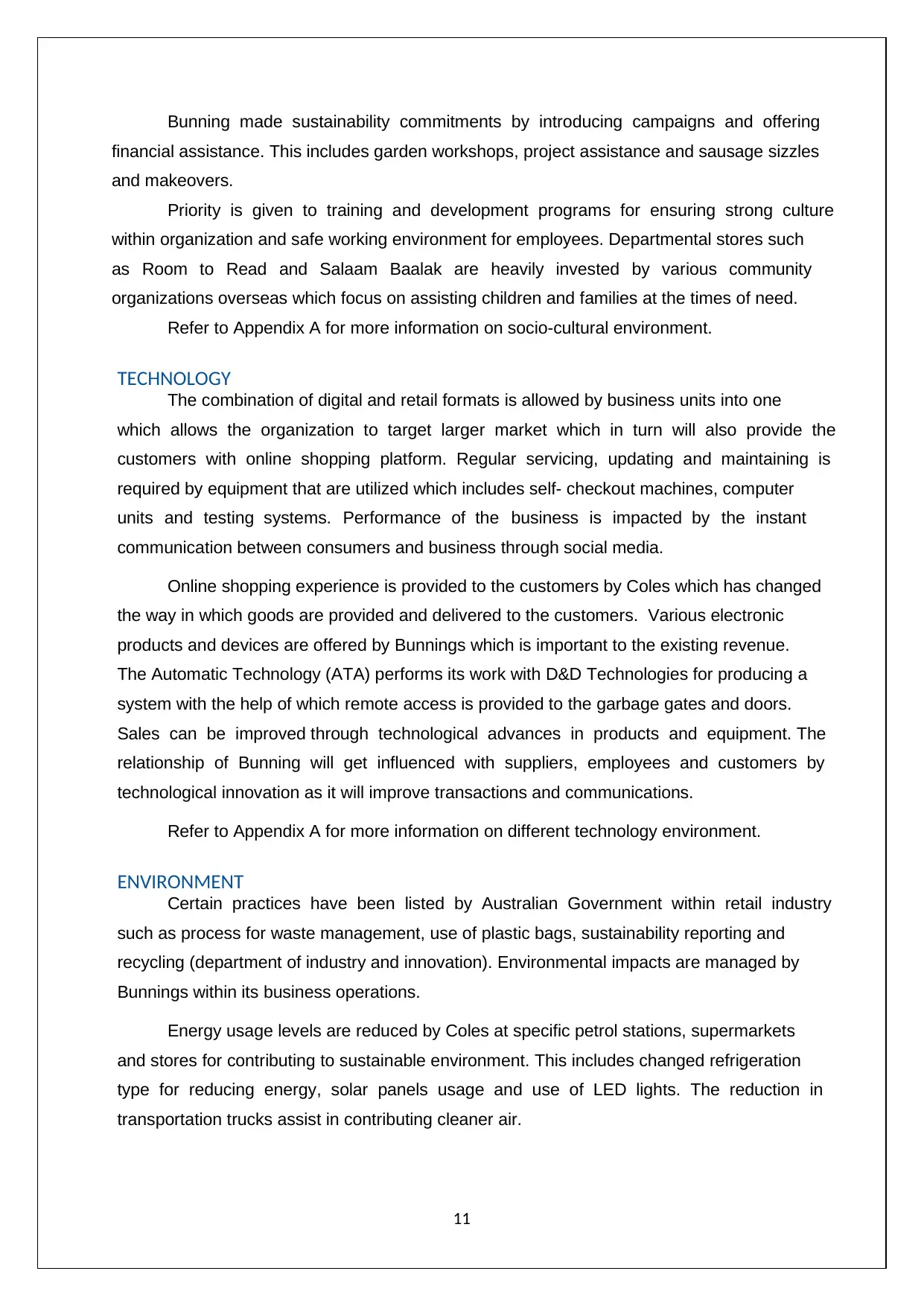
11
Bunning made sustainability commitments by introducing campaigns and offering
financial assistance. This includes garden workshops, project assistance and sausage sizzles
and makeovers.
Priority is given to training and development programs for ensuring strong culture
within organization and safe working environment for employees. Departmental stores such
as Room to Read and Salaam Baalak are heavily invested by various community
organizations overseas which focus on assisting children and families at the times of need.
Refer to Appendix A for more information on socio-cultural environment.
TECHNOLOGY
The combination of digital and retail formats is allowed by business units into one
which allows the organization to target larger market which in turn will also provide the
customers with online shopping platform. Regular servicing, updating and maintaining is
required by equipment that are utilized which includes self- checkout machines, computer
units and testing systems. Performance of the business is impacted by the instant
communication between consumers and business through social media.
Online shopping experience is provided to the customers by Coles which has changed
the way in which goods are provided and delivered to the customers. Various electronic
products and devices are offered by Bunnings which is important to the existing revenue.
The Automatic Technology (ATA) performs its work with D&D Technologies for producing a
system with the help of which remote access is provided to the garbage gates and doors.
Sales can be improved through technological advances in products and equipment. The
relationship of Bunning will get influenced with suppliers, employees and customers by
technological innovation as it will improve transactions and communications.
Refer to Appendix A for more information on different technology environment.
ENVIRONMENT
Certain practices have been listed by Australian Government within retail industry
such as process for waste management, use of plastic bags, sustainability reporting and
recycling (department of industry and innovation). Environmental impacts are managed by
Bunnings within its business operations.
Energy usage levels are reduced by Coles at specific petrol stations, supermarkets
and stores for contributing to sustainable environment. This includes changed refrigeration
type for reducing energy, solar panels usage and use of LED lights. The reduction in
transportation trucks assist in contributing cleaner air.
Bunning made sustainability commitments by introducing campaigns and offering
financial assistance. This includes garden workshops, project assistance and sausage sizzles
and makeovers.
Priority is given to training and development programs for ensuring strong culture
within organization and safe working environment for employees. Departmental stores such
as Room to Read and Salaam Baalak are heavily invested by various community
organizations overseas which focus on assisting children and families at the times of need.
Refer to Appendix A for more information on socio-cultural environment.
TECHNOLOGY
The combination of digital and retail formats is allowed by business units into one
which allows the organization to target larger market which in turn will also provide the
customers with online shopping platform. Regular servicing, updating and maintaining is
required by equipment that are utilized which includes self- checkout machines, computer
units and testing systems. Performance of the business is impacted by the instant
communication between consumers and business through social media.
Online shopping experience is provided to the customers by Coles which has changed
the way in which goods are provided and delivered to the customers. Various electronic
products and devices are offered by Bunnings which is important to the existing revenue.
The Automatic Technology (ATA) performs its work with D&D Technologies for producing a
system with the help of which remote access is provided to the garbage gates and doors.
Sales can be improved through technological advances in products and equipment. The
relationship of Bunning will get influenced with suppliers, employees and customers by
technological innovation as it will improve transactions and communications.
Refer to Appendix A for more information on different technology environment.
ENVIRONMENT
Certain practices have been listed by Australian Government within retail industry
such as process for waste management, use of plastic bags, sustainability reporting and
recycling (department of industry and innovation). Environmental impacts are managed by
Bunnings within its business operations.
Energy usage levels are reduced by Coles at specific petrol stations, supermarkets
and stores for contributing to sustainable environment. This includes changed refrigeration
type for reducing energy, solar panels usage and use of LED lights. The reduction in
transportation trucks assist in contributing cleaner air.
⊘ This is a preview!⊘
Do you want full access?
Subscribe today to unlock all pages.

Trusted by 1+ million students worldwide
1 out of 25
Related Documents
Your All-in-One AI-Powered Toolkit for Academic Success.
+13062052269
info@desklib.com
Available 24*7 on WhatsApp / Email
![[object Object]](/_next/static/media/star-bottom.7253800d.svg)
Unlock your academic potential
Copyright © 2020–2025 A2Z Services. All Rights Reserved. Developed and managed by ZUCOL.





